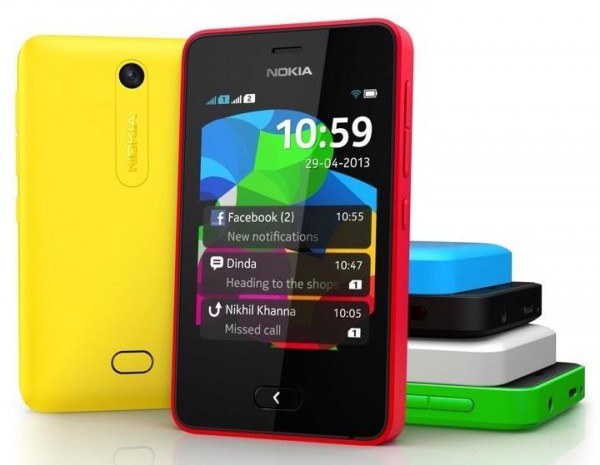With a refreshed design and software, the candy-colored Nokia Asha 501 turns a new page for the Finnish feature-phone lineup. Low-end Android smartphones continue to be the main target but, for the first time the Ashas, which Nokia has always insisted on calling smart, are walking the walk.
No more of the cheap gloss of the older generations, the hardware call keys are gone too – the styling is simple but finally looks relevant and up-to-date. Touchscreen is in charge and the single Back key under the display is a major feature of the new look and feel – even if it plays a very small part in the actual navigation.
The Nokia Asha 501 is premiering the Asha platform 1.0 – the redesigned interface is heavily swipe-driven – a trend that goes back to the previous Asha generation, but with the right bit of polish and fluency.
Nokia Asha 501 at a glance:
- General: GSM 900 / 1800 MHz; GPRS up to 85.6 Kbps, EDGE up to 236.8 Kbps
- Dual SIM support: Optional, GSM 900 / 1800 MHz, dual SIM standby, EasySwap
- Form factor: Touchscreen bar phone
- Dimensions: 99.2 x 58 x 12.1 mm, 98.2 g
- Display: 3″ 256K-color QVGA (240 x 320 pixels) TFT capacitive touchscreen, 133 ppi, scratch-resistant glass
- OS: Nokia Asha software platform 1.0
- Memory: 128 MB of inbuilt storage, microSD card slot, 4GB card in the bundle
- Still Camera: 3.15 megapixel fixed-focus camera
- Video Camera: QVGA (240 x 320) video recording at 15fps
- Connectivity: Wi-Fi b/g, Bluetooth 3.0 with EDR, microUSB port, 3.5mm audio jack
- Battery: 1,200mAh
- Misc: Built-in accelerometer, proximity sensor, FM radio, exchangeable covers
The version of the Nokia Asha 501 we have for this quick hands-on is the one with dual-SIM support. There’s no side-mounted SIM compartment this time around, but there’s still a hot-swappable SIM and a dedicated SIM manager that can remember the settings for up to five cards.
Long battery life, Wi-Fi, a reasonably stocked app store and exchangeable covers make this a compelling package, and a very affordable one at that. It’s a nice little phone that looks fresh both on the outside and inside.
Design and handling
There’s design and build of the Nokia Asha 501 has got little to do with older Asha generations. And we mean that in all the good ways possible. The phone manages to make an impression with its colorful outer shell. The back cover that folds around the inner body comes in a candy-box variety of colors.
Up front, the 3″ screen has an ample bezel around it but that’s nothing out of the ordinary in the price bracket. The bigger problem is that the black front is a bit at odds with the bright-colored rear. On a positive note, the capacitive touchscreen is quite responsive and comes with a scratch-resistant coating. The hardware Back button is the only control below the screen, the earpiece symmetrically placed across. The microphone is in the bottom right corner.
There’s no brightness sensor but Nokia has included a proximity sensor, which turns the screen off during a call. The back button is pleasingly firm and springy, slightly raised above the surrounding glass surface and therefore easy to locate by touch.
The Asha 501 essentially breaks down to two parts, which is obviously the second most solid construction after unibody. The colorful shell folds around the inner body, resulting in a slim colorful frame around the screen as an accent. At the back we find the 3.15 MP camera lens along with a Nokia logo and a nub at the bottom to push the phone out of the case.
The plastic used is nice to the touch, with a soft matte finish that completely rules out fingerprints.
Overall, we quite like the Asha 501’s design. The phone is extra pleasant to hold and work with. What we’re most impressed with is how such a simple design makes a huge difference compared to the older Asha generation. The Lumia influence is easily spotted – a great way to update an old, stale look while providing consistency and continuity in the Nokia portfolio – from feature phones to smartphones.
The eye-popping colors also add to the fresh feel of the device.
Nokia has managed to perfectly balance materials and finish, battery life, Dual-SIM support and costs. The Asha 501 is a perfect mix of affordable and portable, but also good-looking and up-to-date.
Display
The display on the Nokia Asha 501 is a 3″ TFT unit of QVGA (240 x 320) resolution, which boils down to around 133ppi. The screen is capacitive and has multi-touch support.
Colors are nice and punchy and the screen is reasonably bright. Size may be an issue, as well as resolution, but the responsiveness has been notably improved from what we remember with the older Asha phones.
Browsing the web and watching videos isn’t the most compelling experience on a screen of that screen size and resolution of course.
And here go the stats – contrast levels are pretty good but the brightness isn’t all that impressive on paper. Blacks are good too.







